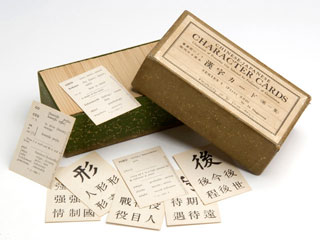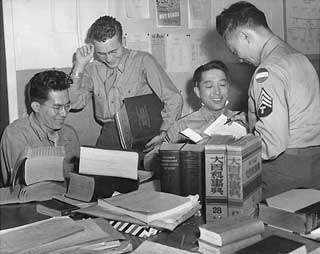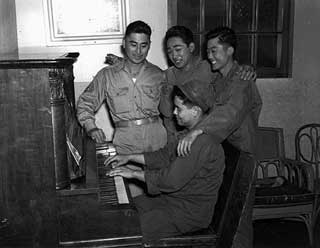Edwin Nakasone: "I was very happy there."
Edwin Nakasone was drafted on August 10, 1945. He was tested for Japanese language proficiency and, after basic training, was sent to Fort Snelling in Minnesota to the Japanese Language School for training as interpreters with the occupation forces. He finished his training in Monteray, California in December 1946, and was sent to Japan. In a 2003 interview with Thomas Saylor, he remembered his experiences while at Fort Snelling.
Audio
Transcript
TS: What are your memories of Fort Snelling, indeed of Minnesota, as a person coming from a very different background?
EN: Excellent. Excellent. Treatment was very good, as I told you. The people were very - indeed happy to have us it seems. We enjoyed the participation at Fort Snelling. Fort Snelling's buildings were nice and big and large. I was in Company C.
TS: It was a rather extensive facility, wasn't it?
EN: Yes. Yes. You had a hospital there. You had a post theater. You had the PX. You had a saddlery shop. You had commissary. You had—it was a big post, a really big post. And so close to town. So close to Minneapolis-St. Paul. And then on top of that, Tom, when we were really [unclear] with the idea that we had to go into one of these dances. At of those dances, one of the nursing students that we got to know pretty well came along and she said, "Pardon me sir, why don't you come? Are you free this weekend?" "Yes, I think I'm free, why?" "I'd like you to come down and meet my family, my folks, in Fairmont, Minnesota, southern Minnesota." "How far is it?" "About twenty-five, thirty miles south. We could take the bus." "You really don't want me because I'm of Japanese ancestry. Your parents may not..." "Oh, yes, they will understand. They know about Japanese [American] soldiers. I've been telling them about you and they would like to be able to meet you." So I did go down with her by bus and they treated me like a son returned home. And I was very, very happy there.
TS: Were you nervous going down there at first?
EN: In a way I was, yes, because I didn't—remember, we had just come from the South in Fort McClellan, Alabama. Colored people only and so on. The fact is, we did not know that when we went into the bus. I remember in Atlanta, when we had a little liberty there, the bus driver looked back over there and we were on the back seat, which is a way of doing things in Hawaii. The bus driver stopped. "I want you boys come in beyond that white line! That's designed only for the colored personnel!" I also realized that even though you're not white you should use the white facilities and not the colored facilities, and that made it clear to us.
TS: So you were—for the people in the South you were white.
EN: Yes.
TS: Interesting. This experience in Minnesota. It sounds like you felt comfortable here. Can you talk about the language training, the school that you went to up here?
EN: As I said, we did not—I came in December of 1945 but we did not have our classes begin until March [1946]. But they did test us. And we had twenty-two sections of Japanese language. Every section would have maybe about twelve, fifteen people. I remember being in section fourteen of twenty-two. So I was in the middle. By the time we got done I had progressed to section eleven.
I enjoyed learning the language. I enjoyed the times. Mondays through Fridays I would sit in classes. Tuesdays and Thursdays we had two hours of study hall. We would be marched over for study hall. Study in the barracks also. And we had occasion to go out to Minneapolis-St. Paul. We learned—basic one was Kanji. Kanji means character. You have characters in Japanese adapted from the Chinese. You had to learn those because you can’t read anything without learning Kanji. And you have to learn grammar. And we did that. And you had Kaiwa, conversational Japanese, where you would have to take another person and interrogate that person and just plain talk about, "What are you going to do this week? What are you going to do this weekend?"
TS: So basic question and answer skills?
EN: Yes. And we got tested quite often.
TS: Were all the people in this class of Japanese descent?
EN: Yes.
TS: There were no whites learning Japanese as well?
EN: The value of those two classes were all Nisei and Japanese ancestry, but in adjoining classes in a separate location there were classes that were being given to Caucasians. Soldiers. And most of them, I think the majority, were already second lieutenants or something like that. They were being given basic Japanese.
TS: People who were also headed for occupation duty in Japan.
EN: That's true. But the idea is, they're going there as an officer. We were going there as enlisted folks. And that sometimes rubbed wrong, because we feel that we are better background in the language and the culture and history and to be able to interrogate. We were the ones who would interrogate and interpret in the field. These guys would be just signing off [on orders, as officers]. They drew more money. They had more respect than us. And we would be dogs.
TS: You were the enlisted.
EN: Yes.
Source
Nakasone, Edwin; Thomas Saylor, Interviewer, Minnesota's Greatest Generation Oral History Project, Thomas Saylor; Minnesota Historical Society Oral History Collection, 2003.
Osman, Stephen E. Osman Fort Snelling's Last War. Minnesota Historical Society: Minnesota's Greatest Generation Project Web Site, 2006.
Ano, Masaharu, Loyal Linguists: Nisei of World War II Learned Japanese in Minnesota. Minnesota History Quarterly, Fall 1977, Vol. 45, No. 7, p. 273-287.
Saylor, Thomas, Remembering the Good War. Minnesota Historical Society Press, 2005.






